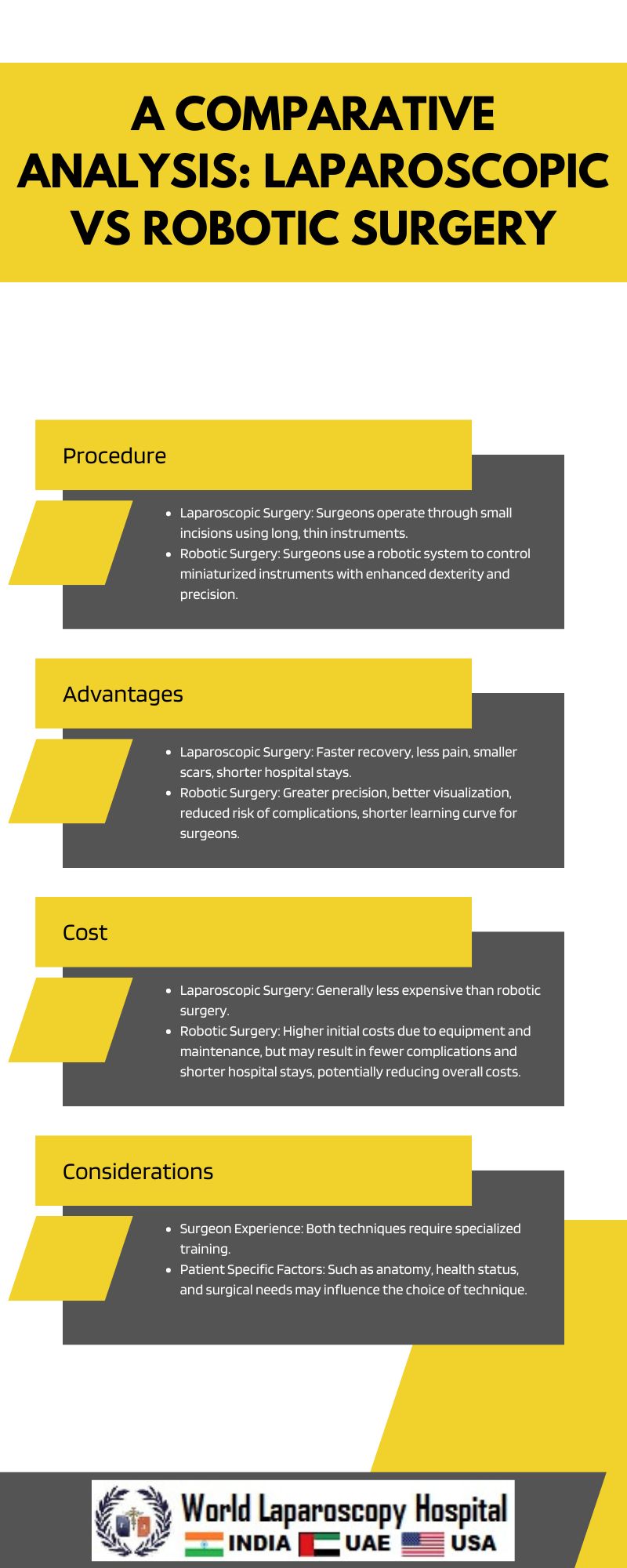Introduction
Surgical procedures have evolved significantly over the years, with laparoscopic and robotic surgery emerging as two prominent minimally invasive techniques. Both approaches offer benefits over traditional open surgery, such as reduced pain, shorter hospital stays, and faster recovery times. However, there are differences between the two techniques that are worth exploring. This article provides a comparative analysis of laparoscopic and robotic surgery, highlighting their similarities, differences, advantages, and limitations.

Laparoscopic Surgery
Laparoscopic surgery, also known as minimally invasive surgery (MIS) or keyhole surgery, involves making small incisions in the abdomen through which a laparoscope and other surgical instruments are inserted. The laparoscope is a long, thin tube with a high-resolution camera and light source that allows the surgeon to see inside the body and perform the surgery.
Advantages of Laparoscopic Surgery:
Reduced trauma to the body: Laparoscopic surgery requires smaller incisions compared to open surgery, leading to less trauma to the surrounding tissues and organs.
Faster recovery: Patients undergoing laparoscopic surgery typically experience less pain and a quicker recovery time compared to open surgery.
Shorter hospital stay: Due to the minimally invasive nature of the procedure, patients often require a shorter hospital stay, which can lead to cost savings.
Reduced risk of infection: The smaller incisions in laparoscopic surgery reduce the risk of postoperative infections.
Limitations of Laparoscopic Surgery:
Limited range of motion: The instruments used in laparoscopic surgery have limited range of motion compared to the human hand, which can make some surgical tasks more challenging.
Steeper learning curve: Laparoscopic surgery requires specialized training for surgeons due to the complexity of operating with long instruments and a two-dimensional view.
Robotic Surgery
Robotic surgery is a form of minimally invasive surgery that uses a robotic system to assist the surgeon. The system consists of a console where the surgeon sits, a patient cart with robotic arms, and a high-definition 3D camera. The surgeon controls the robotic arms from the console, which mimic the surgeon's hand movements with greater precision and dexterity.
Advantages of Robotic Surgery:
Enhanced precision: The robotic system provides surgeons with a magnified, 3D view of the surgical site and allows for more precise movements, especially in confined spaces.
Improved dexterity: The robotic arms can mimic the movements of the human hand with greater flexibility and range of motion.
Reduced fatigue: The ergonomic design of the robotic console reduces surgeon fatigue during long procedures.
Faster recovery: Like laparoscopic surgery, robotic surgery typically results in a faster recovery time compared to open surgery.
Limitations of Robotic Surgery:
Cost: Robotic surgery can be more expensive than laparoscopic surgery due to the cost of the robotic system and maintenance.
Lack of tactile feedback: Unlike traditional surgery, robotic surgery does not provide tactile feedback to the surgeon, which can make it challenging to gauge tissue characteristics.
Comparative Analysis
Both laparoscopic and robotic surgery offer significant advantages over traditional open surgery in terms of reduced pain, shorter hospital stays, and faster recovery times. However, there are key differences between the two techniques that should be considered.
Precision and Dexterity:
Robotic surgery offers enhanced precision and dexterity compared to laparoscopic surgery, thanks to the robotic arms' ability to mimic the surgeon's hand movements with greater flexibility and range of motion. This can be particularly advantageous in complex procedures that require intricate maneuvers.
Learning Curve:
While both laparoscopic and robotic surgery require specialized training for surgeons, robotic surgery may have a steeper learning curve due to the complexity of operating the robotic system. Surgeons need to undergo extensive training to become proficient in using the robotic system effectively.
Cost:
One of the major drawbacks of robotic surgery is its cost. The initial investment in the robotic system and ongoing maintenance costs can be substantial, making robotic surgery more expensive than laparoscopic surgery. This cost factor can limit the accessibility of robotic surgery to some patients and healthcare facilities.
Tactile Feedback
One of the limitations of robotic surgery is the lack of tactile feedback. Unlike laparoscopic surgery, where the surgeon can feel the tissues and organs, robotic surgery relies solely on visual feedback. This lack of tactile feedback can make it challenging for surgeons to assess tissue characteristics accurately.
Conclusion
In conclusion, both laparoscopic and robotic surgery are valuable minimally invasive techniques that offer significant benefits over traditional open surgery. While laparoscopic surgery is more widely practiced and has a lower cost, robotic surgery provides enhanced precision and dexterity, especially in complex procedures. The choice between the two techniques depends on various factors, including the surgeon's skill level, the complexity of the procedure, and the patient's preferences. Ultimately, both techniques continue to advance, offering new possibilities for minimally invasive surgery.
Laparoscopic surgery's focus on smaller incisions and reduced postoperative complications resonates with its well-established advantages, while robotic surgery's advanced precision and dexterity offer a compelling alternative for complex procedures. The discussion on learning curves and costs adds depth, underscoring the multifaceted considerations in surgical decision-making.
Overall, this article serves as a comprehensive guide for surgeons navigating the evolving landscape of modern surgical techniques, providing valuable insights for informed decision-making and patient care.